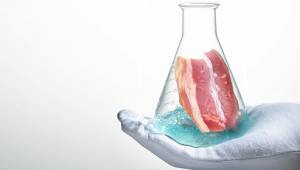11:06 The $325,000 Lab-Grown Hamburger Now Costs Less Than $12 |
 The artificial burger that you—or your science-fiction-loving friends—have been waiting for is real. And now it's cheap, too. It wasn't long ago that test-tube hamburgers—meat made from small pieces of lab-grown animal muscle tissue—were just a glimmer in some mad scientist's eye. Then, in 2013, the dream of an artificial burger suddenly got interesting. That's when Mark Post, a researcher at Maastricht University in the Netherlands, announced that he had created a burger made from real meat grown in a lab (20,000 strips of muscle tissue, to be exact) for the unreasonable price of $325,000. Now that price has dropped to just over $11 for a burger ($80 per kilogram of meat), according to a recent ABC News interview with Post. Here's how Co.Exist described Post's experiment back in 2013:
It hardly sounds appetizing, and, according to those who tried the burger back when it was first announced, it still had a ways to go in the flavor department. But it wasn't terrible. While the price of the burger has dropped to almost-reasonable prices, Post told ABC that it will still be another 20 to 30 years before it's commercially viable. Among the hurdles still left to overcome: figuring out how to produce test-tube meat at scale, and coming up with a way to produce it that doesn't use fetal calf serum (currently, cells are grown in the serum, which is taken from cow fetus blood). And, of course, there's the biggest hurdle of all: convincing people to eat lab-grown meat. |
| Категория: Technology | Просмотров: 1281 | |
| Всего комментариев: 0 | |



